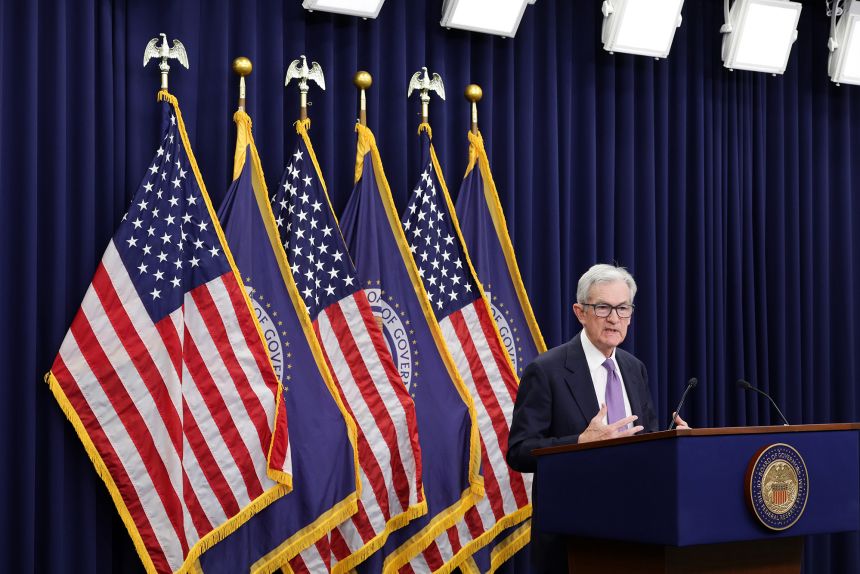For the second time this year, the Federal Reserve on Wednesday decided to lower its key interest rate by a quarter of a percentage point.
Federal Reserve Chair Jerome Powell noted during a briefing with reporters on Wednesday that it is not a foregone conclusion that the central bank will opt for third rate cut this year at its upcoming December meeting.
For now, though, the Fed’s move on Wednesday will affect various consumer savings and lending rates throughout the economy.
How? In brief, it may make it a little harder — but still possible — to find attractive, inflation-beating yields for your savings if you comparison shop. And on your debts, the Fed’s moves may save you some money but not nearly as much as your taking advantage of other options. More on all that below.
Best bets for savings
Even if the rates available today move down a bit given the Fed’s latest move, there are still plenty of low-risk options that let you grow your savings and protect your purchasing power.
Online high-yield savings accounts: Online high-yield savings accounts at many small FDIC-insured banks are still offering yields north of 4%, far higher than the 0.1% you might earn on a traditional bank savings account. Why? Because the online players are competing to attract deposits.
In fact, while many bank account rates typically follow the Fed’s moves quickly, the online high-yield savings accounts rates haven’t fallen as much as the Fed’s overnight lending rate. “Some dropped around 10 basis points, but they haven’t fallen 25 basis points since (the Fed’s cut) last month,” said Ken Tumin, co-founder of DepositQuest.com. In the wake of a full percentage point of cuts by the Fed in 2024, Tumin said, many online high-yield accounts fell by only 60 to 70 basis points.
Money market accounts and funds: Many money market bank accounts at FDIC-insured banks were offering rates of between 3.40% and 4.25% ahead of the Fed meeting, according to Bankrate data.
And money market mutual funds — which are not FDIC insured but nonetheless are considered very low risk for cash — were paying an average of 3.92% as of Tuesday, according to Crane Data.
While the funds’ rates will come down in the coming weeks, they may not do so by quite as much as the Fed rate. For instance, the Vanguard Federal Money Market Fund currently has a 7-day yield of 4.05%. But that is only 15 basis points below the 4.19% it was offering in September right before the Fed cut rates by 25 basis points, Tumin said.

Certificates of deposit: On Schwab.com, the best rates for CDs with terms of anywhere from three months to five years were between 3.6% and 3.95% on Wednesday. Those rates may come down some in the coming days, but they will still exceed the latest 3% inflation reading.
Normally, if you withdraw money from a CD before it matures, you forfeit some of your interest earnings. But some banks offer what are called no-penalty CDs for up to 13 months. You get to lock in your rate for that time period but can take the money sooner without penalty. One such no-penalty CD is currently on offer by Marcus for 3.95%.
You can buy a CD direct from banks, some of which are offering very attractive rates north of 4%, Tumin said. Or you can buy CDs from banks around the country through your brokerage — which give you the option to trade it before the term ends, which could result in a capital gain or loss depending on the price the day you sell. Ideally, if you plan to hold a CD to term, try to find one that is not callable, meaning the issuer won’t recall it before the term ends.
Treasuries and municipal bonds: On Wednesday ahead of the Fed’s announcement, T-bills (with durations up to 52 weeks) had average yields ranging from 3.63% to 3.81% per offerings on Schwab.com.
Treasury notes (with durations from two to 10 years) had average yields between 3.50% and 3.99%.
And AAA-rated municipal bonds (with durations up to 4 years) had rates from 2.43% to 3.46%.
After the Fed’s meeting, bond prices fell, pushing yields higher.
How much interest you actually net from cash-equivalent and fixed-income investments like CDs and federal and local government bonds depends on how they’re taxed. CD interest is taxed at the federal, state and local levels, while yields on Treasury bills, notes and bonds are usually exempt from state and local income taxes. Municipal bond interest, meanwhile, is usually exempt from federal income taxes — and may be completely tax free if you buy a muni issued by your home state, city or county.
So, when deciding between CDs and bonds, compare the after-tax yield you’d get in order to figure out which offers you the best deal.
Or, if you don’t want to buy individual bonds through your brokerage or via TreasuryDirect.gov, you might consider a low-cost intermediate-term Treasury bond index fund.
Managing debt as rates come down
How much debt you choose to take on, how quickly you plan to pay it off and how high you can get your credit score before applying for a loan may save you more money than a small rate cut or two from the Fed.
Credit cards: Take credit cards. The average rate is still a hair north of 20%, according to Bankrate. And, per Lending Tree, the average rate on a new credit card is 24.19%.

So, if you’re carrying debt from month to month and paying double-digit interest rates – never mind 20% or more – forget the Fed. “(By) getting a 0% balance transfer credit card or even simply calling your lender and asking for a lower rate, you can find significantly bigger reductions than you’re likely to ever get from the Fed,” said Matt Schulz, chief consumer finance analyst at Lending Tree.
Mortgages and home equity loans: Rates on mortgages track movements in the 10-year Treasury yield, which moves in anticipation of Fed rate decisions and other economic indicators.
The average mortgage rate on a 30-year fixed rate mortgage has fallen by nearly a full percentage point since mid-January (when it was 7.04%). Last week, it came in at 6.19%.
For homebuyers, that drop alone on a $350,000 mortgage amounts to savings of nearly $197 a month.
And for those who already have a mortgage, if your current fixed rate is at least a percentage point higher than what you could get by refinancing, “make a move to refi,” said Stephen Kates, a certified financial planner and Bankrate financial analyst.
As for borrowing against home equity, lending rates have been coming down slowly. As of last week, the average rate on a home equity loan was 8.11% and the variable rate on home equity line of credit (HELOC) was 7.85%, according to Bankrate. They will move lower still over the next few months.
If you already have a variable rate HELOC or are getting a new one, your rate will automatically adjust downward.
If you’re applying for a new fixed-rate home equity loan, you can do more to lower your own rate than just depending on small cuts from the Fed.
“The length of your home equity loan will impact your rate. The longer the loan, the higher the rate,” Kates said.

Just as important, he added, is to focus on improving your credit score, unless it’s already excellent. “If you’re thinking of a renovation in six months, that’s all you should be thinking about. It’s the biggest and quickest way to take a rate down.”
Car loans: You can do more to make a car affordable than a quarter-point cut by the Fed can.
As of September, the average APR was 7% on loans for new vehicles and 10.7% on used ones, while average monthly payments came to $761 and $570, respectively, according to data from Edmunds.com, which also offers a state-by-state breakdown of average rates.
To really keep your monthly payments in check, improve your credit score to qualify for the best rate and don’t buy more car than you need.
“Affordability is still a major hurdle for many shoppers, but the end of the year has traditionally been a popular time to buy. Dealers are eager to clear out 2025 model-year inventory, and November’s Black Friday promotions typically kick off a stretch of holiday deals,” said Jessica Caldwell, Edmunds.com head of insights.
If you’re tempted by low-APR promotions, their terms may be capped at 48 or 60 months. So make sure you can manage those monthly payments. Longer loan terms may offer lower monthly payments, but you will end up paying more in interest in the long run.


